Caliper(s) or calliper(s) may refer to:
Caliper(s) or calliper(s) may refer to:
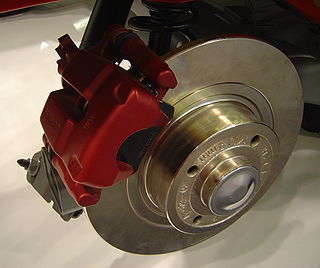
A disc brake is a type of brake that uses the calipers to squeeze pairs of pads against a disc or a "rotor" to create friction. This action slows the rotation of a shaft, such as a vehicle axle, either to reduce its rotational speed or to hold it stationary. The energy of motion is converted into waste heat which must be dispersed.
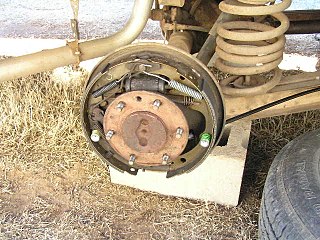
A drum brake is a brake that uses friction caused by a set of shoes or pads that press outward against a rotating cylinder-shaped part called a brake drum.

A vernier scale, named after Pierre Vernier, is a visual aid to take an accurate measurement reading between two graduation markings on a linear scale by using mechanical interpolation, thereby increasing resolution and reducing measurement uncertainty by using vernier acuity to reduce human estimation error. It may be found on many types of instrument measuring linear or angular quantities, but in particular on a vernier caliper which measures internal or external diameter of hollow cylinders.
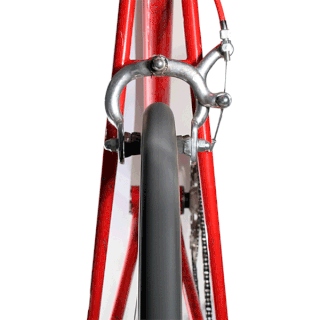
A bicycle brake reduces the speed of a bicycle or prevents it from moving. The three main types are: rim brakes, disc brakes, and drum brakes.

A machinist is a tradesperson or trained professional who operates machine tools, and has the ability to set up tools such as milling machines, grinders, lathes, and drilling machines.

Caliper(s) or calliper(s) are an instrument used to measure the dimensions of an object, generally by placing two movable points of the instrument across the object or span to be measured.
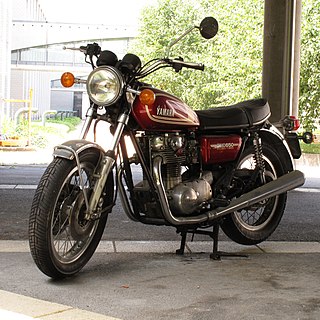
The Yamaha XS650 is a mid-size motorcycle made by Yamaha Motor Company. The standard model was introduced in October 1969,and produced through 1979. The "Special" cruiser model was introduced in 1978 and produced through 1985. The XS650 began with the 1955 Hosk SOHC 500 twin. After about 10 years of producing 500 twin, Hosk engineers designed a 650 cc twin. Later the Hosk company was acquired by Showa Corporation, and in 1960 Yamaha had bought Showa with Hosk's early design of 650 cc twin.
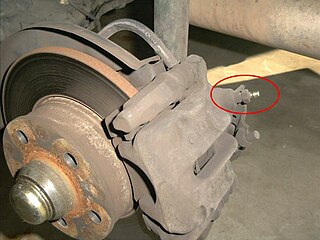
Brake bleeding is the procedure performed on hydraulic brake systems whereby the brake lines are purged of any air bubbles. This is necessary because, while the brake fluid is an incompressible liquid, air bubbles are compressible gas and their presence in the brake system greatly reduces the hydraulic pressure that can be developed within the system. The same methods used for bleeding are also used for brake flushing or purging, where the old fluid is replaced with new fluid, which is necessary maintenance.

Brembo S.p.A. is an Italian manufacturer of automotive brake systems, especially for high-performance cars and motorcycles. Its head office is in Curno, Bergamo, Italy.

A hydraulic brake is an arrangement of braking mechanism which uses brake fluid, typically containing glycol ethers or diethylene glycol, to transfer pressure from the controlling mechanism to the braking mechanism.

In road vehicles, the parking brake, also known as a handbrake or emergency brake (e-brake), is a mechanism used to keep the vehicle securely motionless when parked. Parking brakes often consist of a pulling mechanism attached to a cable which is connected to two wheel brakes. In most vehicles, the parking brake operates only on the rear wheels, which have reduced traction while braking. The mechanism may be a hand-operated lever, a straight pull handle located near the steering column, or a foot-operated pedal located with the other pedals.

A technical pen is a specialized instrument used by an engineer, architect, or drafter to make lines of constant width for architectural, engineering, or technical drawings. "Rapidograph" is a trademarked name for one type of technical pen. Technical pens use either a refillable ink reservoir or a replaceable ink cartridge.
Brake pads are a component of disc brakes used in automotive and other applications. Brake pads are composed of steel backing plates with friction material bound to the surface that faces the disc brake rotors.
In the automotive industry, brake-by-wire technology is the ability to control brakes through electrical means. It can be designed to supplement ordinary service brakes or it can be a standalone brake system.

The Honda CBR1000F Hurricane is a sport touring motorcycle, part of the CBR series manufactured by Honda from 1987 to 1996 in the United States and from 1987 to 1999 in the rest of the world. It is powered by a liquid-cooled, DOHC, 998 cc (60.9 cu in), 16-valve inline-four engine. The CBR1000F, along with the CBR750F and CBR600F, was Honda's first inline four-cylinder, fully-faired sport bike.

A combined braking system (CBS), also called linked braking system (LBS), is a system for linking front and rear brakes on a motorcycle or scooter. In this system, the rider's action of depressing one of the brake levers applies both front and rear brakes. The amount of each brake applied may be determined by a proportional control valve. This is distinct from (conventional) integrated brakes, where applying pressure to the rear brake pedal only applies some braking force to the front brake.
The Ausco-Lambert disc brake is an unusual brake where an axially-expanding shoe assembly is sandwiched between two linked rotating discs. It may be thought of as an "inside out" disc brake: instead of pads pinching a disc, the pads expand inside a hollow disc.
Power brakes consist of a system of hydraulics used to slow down or stop a motor vehicle. It uses a combination of mechanical components and vacuum assistance to multiply the pressure applied to the brake pedal by the driver into enough force to actuate the brakes and stop the vehicle. By contrast, manual brakes rely solely on the pressure the driver applies to the brake pedal.
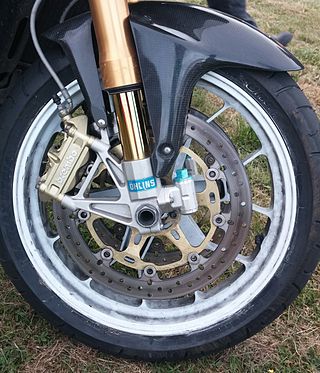
Motorcycle braking systems have varied throughout time, as motorcycles evolved from bicycles with an engine attached, to the 220 mph (350 km/h) prototype motorcycles seen racing in MotoGP. Most systems work by converting kinetic energy into thermal energy (heat) by friction. On motorcycles, approximately 70% of the braking effort is performed by the front brake. This however can vary for individual motorcycles; longer-wheelbase types having more weight biased rearward, such as cruisers and tourers, can have a`greater effort applied by the rear brake. In contrast, sports bikes with a shorter wheelbase and more vertical fork geometry can tolerate higher front braking loads. For these reasons, motorcycles tend to have a vastly more powerful front brake compared to the rear.

A tree caliper is a special caliper to measure the diameter at breast height of a tree. When used in forestry, the term "caliper" can refer to the diameter of a tree's trunk at breast height itself. The measurement is generally made at 4.5 feet (1.4 m) to 5 feet (1.5 m) above the soil.